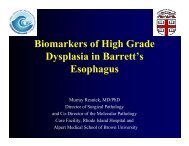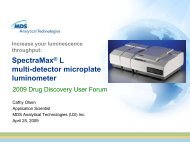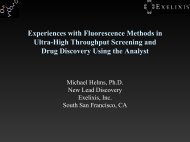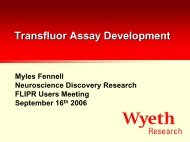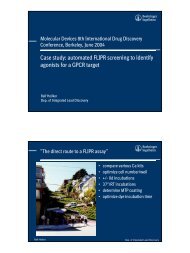The use of the FLIPR in the study of the heterodimeric GABA receptor
The use of the FLIPR in the study of the heterodimeric GABA receptor
The use of the FLIPR in the study of the heterodimeric GABA receptor
Create successful ePaper yourself
Turn your PDF publications into a flip-book with our unique Google optimized e-Paper software.
Introduction• Recently <strong>the</strong> <strong>GABA</strong> B has been cloned and shownto be a heterodimer <strong>of</strong> 2 similar subunits• Here we describe studies which have <strong>use</strong>d <strong>the</strong><strong>FLIPR</strong> to:– pharmacologically characterise <strong>the</strong><strong>heterodimeric</strong> <strong>receptor</strong>– <strong>study</strong> <strong>the</strong> role <strong>of</strong> <strong>the</strong> subunits <strong>in</strong> traffick<strong>in</strong>g <strong>the</strong><strong>receptor</strong> to <strong>the</strong> cell membrane
Pharmacological characterisationEvidence for <strong>GABA</strong> B <strong>receptor</strong> subtypes:• Phacl<strong>of</strong>en reverses bacl<strong>of</strong>en-mediated <strong>in</strong>hibition <strong>of</strong> <strong>GABA</strong>release, but does not reverse bacl<strong>of</strong>en-mediated <strong>in</strong>hibition<strong>of</strong> glutamate release• GHB (γ-hydroxybutyrate) discrim<strong>in</strong>ates GHB -sensitiveand -<strong>in</strong>sensitive <strong>GABA</strong> B <strong>receptor</strong>s• Gabapent<strong>in</strong> has been claimed to be a <strong>GABA</strong> B <strong>receptor</strong>agonist with subunit selectivity
• Recently <strong>the</strong> <strong>GABA</strong> B <strong>receptor</strong> was cloned - shown to consist <strong>of</strong>a heterodimer <strong>of</strong> two subunits – <strong>GABA</strong> B1 (which exists as twosplice variants <strong>GABA</strong> B1a and <strong>GABA</strong> B1b ) and <strong>GABA</strong> B2• We have studied <strong>the</strong> pharmacological pr<strong>of</strong>ile <strong>of</strong> <strong>the</strong>serecomb<strong>in</strong>ant <strong>receptor</strong>s us<strong>in</strong>g radioligand b<strong>in</strong>d<strong>in</strong>g (3H-CGP-54626A) and functional studies
• We have co-expressed <strong>the</strong> <strong>GABA</strong> B1a /<strong>GABA</strong> B2 and<strong>GABA</strong> B1b /<strong>GABA</strong> B2 subunits <strong>in</strong> cells co-express<strong>in</strong>g <strong>the</strong>adapter G-prote<strong>in</strong>, G qi5• This system couples <strong>GABA</strong> B <strong>receptor</strong> activation tochanges <strong>in</strong> <strong>in</strong>tracellular Ca 2+• Changes <strong>in</strong> <strong>in</strong>tracellular Ca 2+ were measured us<strong>in</strong>g <strong>the</strong>Ca 2+ -sensitive dye Fluo-4 us<strong>in</strong>g <strong>the</strong> <strong>FLIPR</strong> (see Wood etal, 2000, Br.J.Pharmacol. 131:1050-1054)
Antagonism <strong>of</strong> <strong>GABA</strong> stimulation on <strong>in</strong>tracellular calciumat <strong>the</strong> <strong>GABA</strong> B1b/B2 dimer% Maximal response10080604020010 -11 10 -1010 -910 -810 -710 -610 -510 -410 -3CGP-46381CGP-35348CGP-54626CGP-62349CGP-55845SCH-50911Phacl<strong>of</strong>enSacl<strong>of</strong>en[Anta gonist].M
Antagonist pr<strong>of</strong>ile<strong>GABA</strong>B1a/B2<strong>GABA</strong>B1b/B2Compound pKB Vs pKi [3H]CGP- pKB Vs<strong>GABA</strong> 54626 <strong>GABA</strong> Bacl<strong>of</strong>enPhacl<strong>of</strong>en
Studies with GHB and <strong>GABA</strong>PENTIN• No agonist activity or antagonist activityat ei<strong>the</strong>r <strong>GABA</strong> B1a/B2 dimer or <strong>GABA</strong> B1b/B2 dimerfor GHB at concentrations up to 10 mMfor Gabapent<strong>in</strong> at concentrations up to 1 mM
Summary• <strong>The</strong> human recomb<strong>in</strong>ant <strong>GABA</strong> B <strong>heterodimeric</strong> <strong>receptor</strong>displays a low sensitivity to <strong>the</strong> antagonists phacl<strong>of</strong>en, sacl<strong>of</strong>enand CGP 35348 and was not modulated by GHB• This is consistent with a phacl<strong>of</strong>en- and GHB-<strong>in</strong>sensitivesubtype <strong>of</strong> <strong>the</strong> <strong>GABA</strong> B <strong>receptor</strong>• Gabapent<strong>in</strong> did not act as an agonist at ei<strong>the</strong>r <strong>the</strong> <strong>GABA</strong> B1a/2 or<strong>GABA</strong> B1a/2 heterodimers
Summary cont• But, <strong>in</strong>-vivo and <strong>in</strong>-vitro, <strong>the</strong> majority <strong>of</strong> <strong>GABA</strong> B -mediatedresponses are sensitive to phacl<strong>of</strong>en• Are <strong>the</strong>re o<strong>the</strong>r <strong>GABA</strong> B sub-units?• Are <strong>the</strong>re o<strong>the</strong>r components which are miss<strong>in</strong>g <strong>in</strong> <strong>the</strong>recomb<strong>in</strong>ant system e.g. accessory prote<strong>in</strong>s• Is <strong>the</strong> signall<strong>in</strong>g mechanism faithful?• Need to <strong>study</strong> dist<strong>in</strong>ct <strong>GABA</strong> B <strong>receptor</strong> subunitcomb<strong>in</strong>ations <strong>in</strong> physiological conditions- cell l<strong>in</strong>e withnative <strong>GABA</strong> B <strong>receptor</strong> ?
<strong>GABA</strong> B1 and <strong>GABA</strong> B2 deletion and chimera constructs<strong>GABA</strong> B1bc-mycTMD 1-7C-C<strong>GABA</strong> B1b∆806<strong>GABA</strong> B1b∆771<strong>GABA</strong> B1b∆747<strong>GABA</strong> B2<strong>GABA</strong> B2∆748<strong>GABA</strong> B2/1bC<strong>GABA</strong> B1b/2C
Expression <strong>of</strong> <strong>GABA</strong> B1 deletion constructs<strong>GABA</strong> B1b<strong>GABA</strong> B1b∆806<strong>GABA</strong> B1b∆771- TX-100 + TX-100<strong>GABA</strong> B1b∆747
Expression <strong>of</strong> <strong>GABA</strong> B2 deletion & chimera constructs- TX-100 + TX-100<strong>GABA</strong> B2<strong>GABA</strong> B2∆748<strong>GABA</strong> B2/1bC
<strong>GABA</strong> B2 takes <strong>GABA</strong> B2/1bc to <strong>the</strong> cell surface- TX-100<strong>GABA</strong> B2/1bC+<strong>GABA</strong> B2
Antagonist b<strong>in</strong>d<strong>in</strong>g to <strong>GABA</strong> B1D747 is displaced by <strong>GABA</strong><strong>GABA</strong>B1b+ <strong>GABA</strong>B2<strong>GABA</strong> B1b<strong>GABA</strong> B1b∆747% Specific [ 3 H]CGP-54626 b<strong>in</strong>d<strong>in</strong>g100806040200Untransfected HEK293-6-4log [<strong>GABA</strong>] (M)-2
Functional evaluation <strong>of</strong> <strong>GABA</strong> B deletion and chimera constructs6000600012000100004000Untransfected cells40008000FIU<strong>GABA</strong> B1b<strong>GABA</strong> B1b∆747FIU<strong>GABA</strong> B1b + <strong>GABA</strong> B2FIU60002000<strong>GABA</strong> B1b/2C20004000<strong>GABA</strong> B1b∆747+ <strong>GABA</strong> B2∆74800-8-6-4-8<strong>GABA</strong> B1b + <strong>GABA</strong> B2-4-6-8<strong>GABA</strong> B1b∆747 + <strong>GABA</strong> B2-420000-6Log [<strong>GABA</strong>] (M)Log [<strong>GABA</strong>] (M)Log [<strong>GABA</strong>] (M)
Novel sites <strong>of</strong> <strong>in</strong>teraction between <strong>the</strong> two <strong>GABA</strong> B <strong>receptor</strong> subunitsNH 2NH 2??<strong>GABA</strong> B1<strong>GABA</strong> B2CC
Summary• <strong>The</strong> C-term<strong>in</strong>al doma<strong>in</strong> <strong>of</strong> <strong>GABA</strong> B1 mediates <strong>the</strong><strong>in</strong>tracellular retention <strong>of</strong> this subunit• Interaction between <strong>GABA</strong> B1 and <strong>GABA</strong> B2 alsooccurs at sites o<strong>the</strong>r than <strong>the</strong> C-term<strong>in</strong>al coilcoildoma<strong>in</strong>• Cell surface <strong>GABA</strong> B1 is only functional when coexpressedwith <strong>the</strong> <strong>GABA</strong> B2 subunit
Conclusions• <strong>The</strong> <strong>FLIPR</strong> is a versatile tool which can be <strong>use</strong>dfor a variety <strong>of</strong> purposes• Pharmacological characterisation <strong>of</strong> expressed<strong>receptor</strong>s• Probe for <strong>receptor</strong> function
AcknowledgementsNeuroimag<strong>in</strong>gKelly CharlesGuillame HervieuMartyn EvansBiotechnology and GeneticsMelanie StammersIsro GlogerChemistryMervyn ThompsonGene Expression SciencesSimon RiceOwen Jenk<strong>in</strong>s





